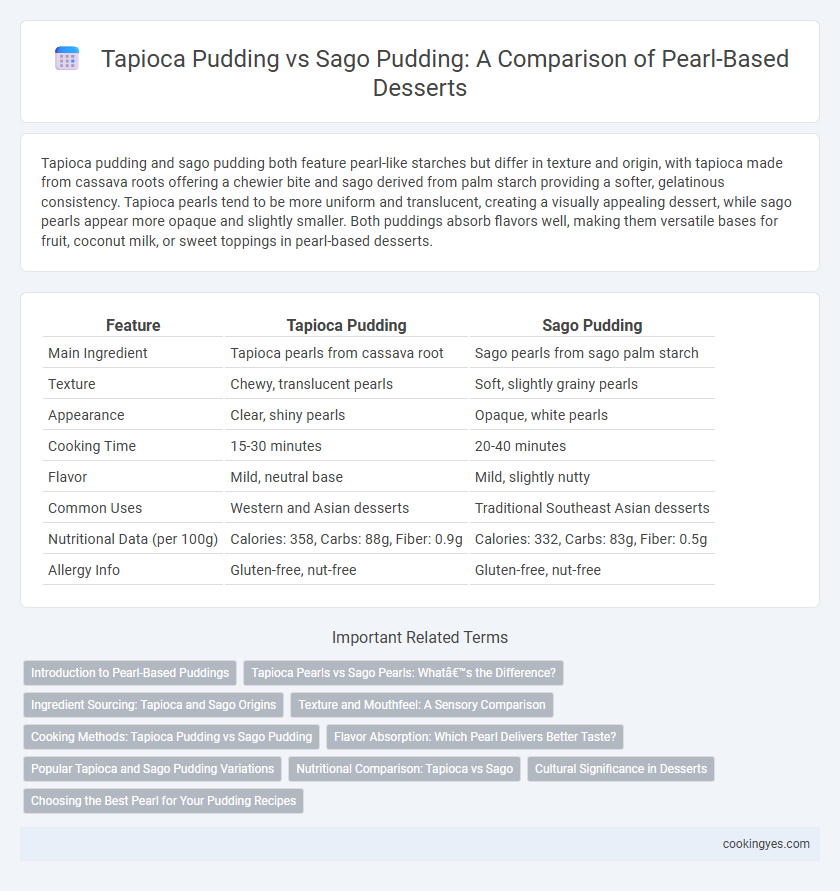Tapioca pudding and sago pudding both feature pearl-like starches but differ in texture and origin, with tapioca made from cassava roots offering a chewier bite and sago derived from palm starch providing a softer, gelatinous consistency. Tapioca pearls tend to be more uniform and translucent, creating a visually appealing dessert, while sago pearls appear more opaque and slightly smaller. Both puddings absorb flavors well, making them versatile bases for fruit, coconut milk, or sweet toppings in pearl-based desserts.
Table of Comparison
| Feature | Tapioca Pudding | Sago Pudding |
|---|---|---|
| Main Ingredient | Tapioca pearls from cassava root | Sago pearls from sago palm starch |
| Texture | Chewy, translucent pearls | Soft, slightly grainy pearls |
| Appearance | Clear, shiny pearls | Opaque, white pearls |
| Cooking Time | 15-30 minutes | 20-40 minutes |
| Flavor | Mild, neutral base | Mild, slightly nutty |
| Common Uses | Western and Asian desserts | Traditional Southeast Asian desserts |
| Nutritional Data (per 100g) | Calories: 358, Carbs: 88g, Fiber: 0.9g | Calories: 332, Carbs: 83g, Fiber: 0.5g |
| Allergy Info | Gluten-free, nut-free | Gluten-free, nut-free |
Introduction to Pearl-Based Puddings
Pearl-based puddings, such as tapioca pudding and sago pudding, are distinguished by their use of small, starchy pearls that provide a unique texture and visual appeal. Tapioca pearls, derived from cassava starch, offer a chewy consistency and translucent appearance, making them a popular choice in desserts worldwide. Sago pearls, extracted from the pith of sago palms, have a similar size but tend to be softer and more opaque, contributing subtle differences in flavor and mouthfeel in pearl-based puddings.
Tapioca Pearls vs Sago Pearls: What’s the Difference?
Tapioca pearls, derived from cassava root starch, have a translucent appearance and a chewy texture that thickens quickly when cooked, making them ideal for creamy pudding bases. Sago pearls, sourced from the pith of sago palm stems, are smaller, opaque, and tend to retain a slightly firmer bite after cooking, offering a different mouthfeel in desserts. The primary difference between tapioca and sago pearls lies in their origin and texture, influencing the overall consistency and flavor absorption in pearl-based puddings.
Ingredient Sourcing: Tapioca and Sago Origins
Tapioca pudding is made from tapioca pearls derived from cassava roots, predominantly sourced from South America, while sago pudding uses pearls extracted from the pith of sago palm stems native to Southeast Asia. The differing botanical origins influence the texture and cooking properties of each pudding, with tapioca offering a slightly chewier consistency and sago providing a softer mouthfeel. These regional ingredient sources impact the availability, cost, and traditional recipes associated with each pearl-based dessert.
Texture and Mouthfeel: A Sensory Comparison
Tapioca pudding features small, translucent pearls that create a chewy and slightly gummy texture, offering a tender bite with a smooth mouthfeel. Sago pudding consists of larger, opaque pearls that provide a firmer, more gelatinous texture with a distinct pop, enhancing sensory contrast in each spoonful. Both desserts deliver unique tactile experiences appealing to different preferences in pearl-based pudding textures and mouthfeel.
Cooking Methods: Tapioca Pudding vs Sago Pudding
Tapioca pudding requires soaking tapioca pearls before simmering them gently in milk or coconut milk until they become translucent and soft, creating a smooth, creamy texture. Sago pudding involves boiling sago pearls directly until they turn fully translucent and sticky, then simmering them with sugar and coconut milk to achieve a chewy consistency. The main difference in cooking methods lies in the soaking step for tapioca, which reduces cooking time and promotes even cooking, while sago pearls must be boiled longer to reach the desired softness.
Flavor Absorption: Which Pearl Delivers Better Taste?
Tapioca pearls excel in flavor absorption, offering a creamy, smooth texture that readily soaks up the surrounding ingredients, enhancing the overall taste of puddings. Sago pearls have a firmer bite but are less efficient at absorbing flavors, resulting in a more neutral palate experience. For pearl-based desserts where flavor infusion is key, tapioca pearls deliver a richer, more pronounced taste profile than sago.
Popular Tapioca and Sago Pudding Variations
Popular tapioca pudding variations include coconut tapioca pudding and mango tapioca pudding, both prized for their creamy texture and subtle sweetness. Sago pudding often features coconut milk and pandan leaves, enhancing its fragrant aroma and smooth consistency. Pearl-based desserts made with tapioca pearls typically have smaller, translucent pearls, while sago pearls are slightly larger and more opaque, influencing the final texture of each pudding.
Nutritional Comparison: Tapioca vs Sago
Tapioca pudding and sago pudding, both pearl-based desserts, differ slightly in nutritional content, with tapioca typically offering higher carbohydrate levels and slightly more calories per serving. Sago, derived from palm stems, contains marginally more fiber and is lower in fat, making it a lighter option. Both puddings are low in protein and vitamins, so their nutritional impact mainly comes from added ingredients like milk or sugar.
Cultural Significance in Desserts
Tapioca pudding, prevalent in Western and Southeast Asian cuisines, holds cultural significance as a nostalgic comfort dessert often associated with family traditions and festive occasions. Sago pudding, widely enjoyed in South and Southeast Asia, carries traditional value in ceremonial meals and religious festivals, symbolizing purity and prosperity. Both pearl-based desserts reflect regional identities through their unique textures and preparation methods, highlighting diverse cultural interpretations of similar ingredients.
Choosing the Best Pearl for Your Pudding Recipes
Tapioca pearls, derived from cassava starch, offer a translucent, chewy texture that harmonizes well with creamy pudding bases, making them ideal for smooth, delicate desserts. Sago pearls, sourced from the sago palm, tend to be smaller and more opaque, providing a firmer bite and a slightly grainier texture that holds shape better in thicker, richer puddings. Selecting between tapioca and sago pearls depends on the desired mouthfeel and appearance, with tapioca favored for silky smoothness and sago preferred for a denser, more textured pudding experience.
Tapioca pudding vs Sago pudding for pearl-based desserts Infographic

 cookingyes.com
cookingyes.com